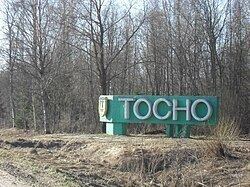Local time Monday 5:56 PM | ||
 | ||
Settlement municipal formation Tosnenskoye Settlement Municipal Formation Municipal district Tosnensky Municipal District Weather 3°C, Wind NE at 11 km/h, 80% Humidity | ||
Tosno (Russian: То́сно) is a town and the administrative center of Tosnensky District in Leningrad Oblast, Russia, located on the Tosna River, 53 kilometers (33 mi) southeast of the center of St. Petersburg. Population: 39,101 (2010 Census); 38,683 (2002 Census); 32,459 (1989 Census).
Contents
- Map of Tosno Leningrad Oblast Russia
- History
- Administrative and municipal status
- Industry
- Transportation
- Culture and recreation
- Notable people
- Twin towns and sister cities
- References
Map of Tosno, Leningrad Oblast, Russia
History
The village of Tosno was first mentioned in Russian chronicles in 1500. It was a part of Vodskaya Pyatina, one of the five pyatinas into which Novgorod Lands were divided. In the course of the administrative reform carried out in 1708 by Peter the Great, Tosno was included into Ingermanland Governorate (known since 1710 as St. Petersburg Governorate). Its development in the 18th and 19th centuries was mainly due to its geographic location on the road between the two Russian capitals. From 1774, it was a station at the yam route. In 1849, the railway connecting Tosno with St. Petersburg and Chudovo opened. In the 19th century, Tosno was a part of Sankt-Peterburgsky Uyezd (renamed in 1913 Petrogradsky Uyezd and in 1924 Leningradsky Uyezd; the governorate was accordingly renamed Petrogradsky in 1913 and Leningradsky in 1924).
On August 1, 1927, the uyezds were abolished and Kolpinsky District, with the administrative center in the town of Kolpino, was established. The governorates were also abolished and the district became a part of Leningrad Okrug of Leningrad Oblast. Tosno became a part of Kolpinsky District. On August 19, 1930, Kolpinsky District was abolished and Tosno became the administrative center of newly established Tosnensky District. On August 20, 1935, Tosno was granted urban-type settlement status. Between August 28, 1941 and January 26, 1944, during World War II, Tosno was occupied by German troops and largely destroyed, but rebuilt after the war. On February 1, 1963, Tosno was granted town status.
Administrative and municipal status
Within the framework of administrative divisions, Tosno serves as the administrative center of Tosnensky District. As an administrative division, it is, together with eighteen rural localities, incorporated within Tosnensky District as Tosnenskoye Settlement Municipal Formation. As a municipal division, Tosnenskoye Settlement Municipal Formation is incorporated within Tosnensky Municipal District as Tosnenskoye Urban Settlement.
Industry
A plant owned by the Caterpillar in Tosno produces trucks for quarries. There are also several enterprises related to construction industry.
Transportation
The M10 Highway connecting Moscow to St. Petersburg and the Moscow–St. Petersburg Railway run through the town. A railway connecting Tosno with the settlement of Shapki branches off east. A railway shortcut connects Tosno with the railway between Mga and Gatchina and is used for trains to bypass Saint Petersburg from the south.
Roads connect Tosno with Shapki and Mga in the east and with Lisino-Korpus and Vyritsa in the west.
Culture and recreation
The town contains seven objects classified as cultural and historical heritage of local significance. They commemorate events of World War II.
Tosno hosts the Tosnensky District Museum, the only state museum in the district.
Notable people
Twin towns and sister cities
Tosno is twinned with:
